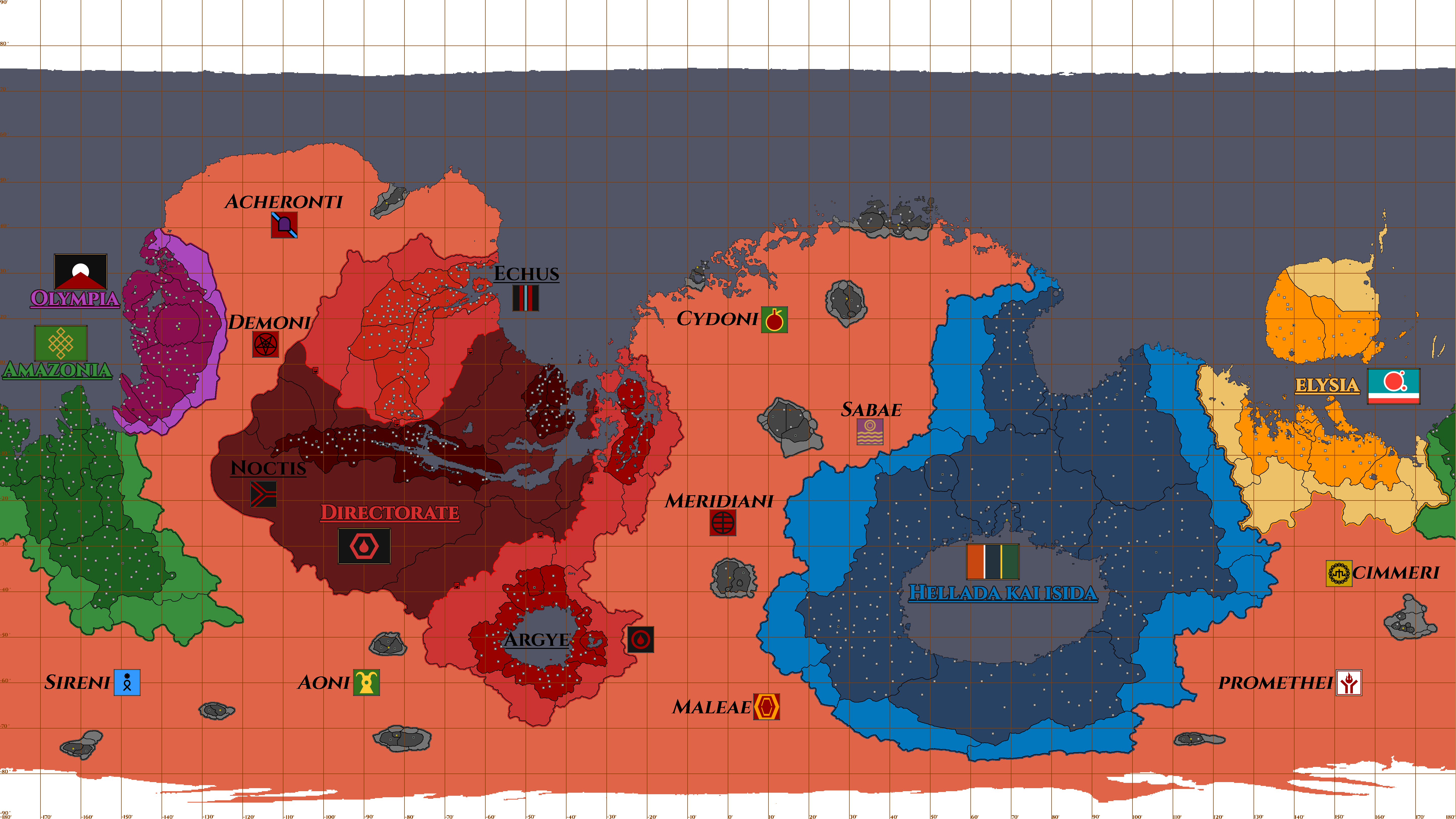HOME | DD
 Esha-Nas — Map of Mars, (1)2500 HE. (New Version/Update!)
Esha-Nas — Map of Mars, (1)2500 HE. (New Version/Update!)

#map #mars #scifi #terraform #terraformed #marsterraformed
Published: 2021-11-22 01:10:14 +0000 UTC; Views: 8865; Favourites: 58; Downloads: 12
Redirect to original
Description
Legend:
White square within a white square: Settlement/base/city.
Red square within a white square: Space Elevator.
Green Square within a white square: Provincial Capital.
Yellow square within a square: National Capital.
Black fist on red background: Warfront.
Lighter color within a national border: Territory/March/Frontier.
Darker color within a national border: Province/State/Region.
Red: Martian Directorate/Directorate. Currently in a three-way civil war between Echus, Noctis, and Argye.
Yellow: Shabiyah of Elysium/Elysia.
Green: Amazonian Matriarchy/Amazonia.
Blue: United Kingdom of Hellas and Isidis/Hellas Kai Isidia.
Purple: Radiance of Olympus/Olympia.
Gray: Free, minor, and smaller polities.
The first planet reached by humanity outside of their own, Mars was long an object of wonder and desire. When the first missions landed in 11963, they found a dead, not dying, world. There were no canals, nor an expected withering civilization in canyons or craters. No life was found, past or present, though water still flowed in the summer near the icy poles over salty soil. Flags were planted, and a few bases, and Mars stood as a curiosity, hosting a few scientific bases, a goal for ascending nations, and a monitoring post for the aggressive powers.
The Martian Compact (Mar- or MaCom) of (1)1980 would change that, however. A returning scientist, LaRoche, popular with the masses of the televised world, went on a campaign to turn Mars into the second home for humanity. The moon was militarized and industrialized, but Mars could offer something different. Fostering the development of shows, interest, activism, and organization, LaRoche's Mars Foundation and the Martian Compact soon came not just into force, but being, with the first United AeroSpatial Agency mission landing under the force of the compact and foundation landing in 1983, and establishing Olympus Base. By 1990, the first redirect mission had slammed a icy comet into the northern hemisphere, and Phobos and Deimos were being surveyed for mining and exploitation.
Then, the Third World War hit Earth. Within a week, and mostly in a single day, most of the belligerent powers were wiped off the map. America, the United Kingdom, France, Germany, China, Russia, Mashriq, Panama, Misr, with the first six having a bulk of spatial capability and presence, fell into chaos, or into tunnels, or silence. Their holdings in space, too, engaged in the suicidal conflict, cluttering orbit with debris flying around the world for decades or destroying holdings and bases on the Moon and, as much as the foundation wished it weren't so, Mars. While the major nations wiped or blasted their presence out of existence, the civilian and neutral powers held on, dug deep, and persevered.
The smoldering wrecks of the war had not yet simmered when the survivors got in contact with each other. Earth still spoke on radio, though in Portuguese, Hindu, Bahasa, Zulu and Xhosa more than English or French. Ships were still available, and the need to turn Mars to a second home seemed stronger than ever. Within a generation, the United Colonial Authority, or UCA, cleaned up ghosts and holdouts on Mars, willingly or not, reconnected with the few left on the Moon, and, with Earth seemingly reaching out to the stars again, set forth on their mission.
Expansive cave systems were formed, though the surface was never wholly abandoned. The atmosphere was strengthened, the caps were melted, bodies of standing water started to form and flow. The temperature increased, and redirected comets and ice chunks from beyond the snow line, from Calisto and Ganymede and further beyond, routinely impacted the northern hemisphere. A magnetosphere was set up, first at the L1 point, and then via latitudinal superconducting rings. Orbital mirrors heated up the planet, and genetically modified plant life was seeded, cultivated, spread. Algae mats and bacterial blooms were encouraged daily, hourly, and soon
seven space elevators stood tall from the Red Planet, with Deimos and Phobos tied to two of them: to one in Isidis, and one across the planet at Olympus. This array of easy access in and out of orbit was a early boon to trade and immigration, but have become as hoo-hum to nearly all as any other work, save for the few who are still amazed by the seemingly near endless coil and rope of graphene and metal, carrying cargo and people as much as they or their forebears did.
Rather quickly, and surprisingly so, Mars had a atmosphere in the hundreds of millibars, temperature ranges along the equator that was tolerable to more diverse forms of life, and the boreal ocean had formed. Everything seemed to be going well.
The early successes led to early nihilism and division. The UCA chafed under the unwelcomed pressure of Earth, or the 'Terran' authorities and parties, who often were falling into upheaval and inefficiency on their own end as Earth warmed beyond their ability to manage, yet still held a strong influence in spatial and extraterrestrial matters due a industrious nature and loyal elements off-world. This came to an end - violently. In the UCA 'Civil' War, Terran elements were purged and Earth put to siege, cowed into silence and isolation, and left be. From then on, all Spatial resources and elements under the UCA would serve the UCA, in whatever project they sought to finish. But there were elements who wanted humanity to spread even further, encouraged settlement in the outer moons, terraforming of other words, interstellar missions, orbital habitats; others wanted to focus on Venus, others on a massive swarm around the sun. Further compacts - the Solar, the Venusian, the Orbital, and so on - would tug the UCA's attention and energy.
The Assembly and The Scourge wars, as anywhere else, were a watershed moment in Martian history. Both had their origins on Mars, and their fetid roots still anchor deep into the planet. In the name of fulfilling the primary task, that of ecological restoration, the Caretaker, a cybernetic 'wetware' being which was entrusted by the UCA to oversee a project that was being increasingly sidelined, ignored, mismanaged, and forgotten about. The suggestion to terraform Calisto and Titan, into 'water worlds' was seen as a frivolous waste by the Caretaker, and the diffusion of mankind into small orbitals was seen as folly, or at the very least, inadvisable in a era of no threat to planetary settlements. Given more and more power and capability to fulfill the Martian Compact, while seemingly helping with the others, the Caretaker was given wide discretionary power, until they were high in the UCA itself.
And then the Caretaker broke ranks. With a small coup, and the declaration of the Martian Assembly for the Martian Compact, or MAMC or just "The Assembly", pro-Martian cadres broke ranks, sabotage and espionage and assassination was widespread, and in one day, half the system was theirs. The Assembly saw mankind's reliance on electronic and robotic machinery and workforces turn against it, with disastrous results at first which led to a near chase across the solar system for surviving forces and fleets, while nearly everything stationary was picked over or besieged. Any orbital habitat that could be destroyed, was, often via long range kinetic weaponry or bombs planted by agents, ending their prevalent use. But The Assembly was short-sighted, with Mars being the twinkle in their eye: UCA forces rallied in the outer system they had built up, and while chased by errant forces, managed to regroup, reorganize, and strike back.
As almost seemingly quick as it began, it was over. The Caretaker was destroyed, their forces scattered to the company level, if that, and the MaCom project handed over to a board. The investment in the outer system, however, the seeming volatility of Mars, and the expansive nature of the war (for The Caretaker had also influenced or infiltrated systems across the system related to MarCom, such as mining bots on Mercury which went rogue) left a lasting impression in Solar System society. MarCom would be once again sidelined, while the outer system flourished, and then the Venusian Compact fully transformed Venus in record time. Mars became a sort of base, than a home, a stopping off point for ships and people going elsewhere. Only Earth was more ignored, while the Moon, Calisto, Ganymede, Titan, Mercury, and so on enjoyed their zenith.
Another threat would emerge from Mars - the Scourge started out in the Cydonian settlements, and to this day that region is abandoned and fallow due to the earliest infestations, which overran most of the surface and a good half or so of the subsurface until beaten back, but had long infiltrated other settlements and planets before then, clouding its origins. Indeed, the first attacks were on the Moon and Ishtar on Venus, and the Scourge is seen as a Ishtarite entity through and through, especially after the central brain evacuated Cydonia and transited across to Venus, despite the efforts of the UCA and allied forces to prevent it. The Scourge war, a biological perversion, would seep deep into biospheres, and many would be transformed and nigh indestructible for centuries to come. Mars again is plagued by this - many cave systems and even parts of the surface are still host to a variety of Scourge biological entities and systems, and many nascent monsters still prowl the deserts, breeding in clutches and crags.
This broke the UCA once more, this time for good. Many fleets would turn to protect their own worlds instead of fighting on a united front, and while there was one last rally to defeat the last known Scourge fleet and chase its flotillas, the UCA as a entity was long dead before its official dissolvement, though successors and pretenders persist.
Mars broke into the Republic of Mars and the Martian Directorate, and the Republic of Mars broke further still. By the present day, the following nations of note are present on Mars:
The strongest power on Mars is the United Kingdom of Hellas and Isidis, a constitutional monarchy with a parliamentary system. Holding itself as a true bastion of democracy and stability on the red world, it is often embroiled in social unrest as many ideologies vie for power within its borders, while a stalwart, expansive military beats back Directorate or Nomadic hordes. The large, militarized, polarized populace, however, does not bode it well as its effectiveness against external and internal threats decay the polity with every passing year, and the divide between North and South - Republican versus Monarchial, almost cut by the great mountains and canal- burns brighter with the passing of time.
Once strong, united, and holding most of the world under their thumb and will, the three successor states of the Martian Directorate are anything but. Once a force whose fleets spread across the system to support allied powers or to impose their will on tributaries and defeated enemies, the Directorate is now in the past. Emerged in a violent and sick civil war, the 'Provisional' and 'Temporary' and 'Interim' Administrations of Echus, Noctis, and Argye all unleash their potent war machines and hordes against the other. Perhaps the Directorate may be united under the old ways yet still? From the squalid swamps of Argye to the flood plains of Echus, a reunited Directorate could take on a ghastly role in the Solar System.
If one is looking for a paradise on Mars, there is truly only one place: the Shabiyah of Elysium, ("Elysia") ostensibly a Federal Republic in the vein of Old America. A bastion of economic and social liberty, any niche or pleasure could be found within its borders, secured by mercenary and bloated military-industrial forces which keep out nomadic, Amazonian, or Directorate forces at bay. With the weather always pleasant and the opportunity always open, if one has enough specie, why even go anywhere else on the planet - Tourism, perhaps, which Elysium also provides, from armed incursions to survey the greatest canyon in the system, Marineris, or guided tours up the biggest mountain in the system, Olympus Mons, to anything else in between - with no liability on the Shabiyah, of course, should one be injured, die, or be left behind.
There are still those who are dedicated to turning Mars green, of course. The Amazonian Matriarchy ("Amazonia") saw the legends and records of Old Earth, Green Earth, of expansive jungles and megafauna and life and vibrancy, and seeks nothing less than to undo the damage and bring into being as much cohesive and muliebral life as possible to Mars, and maybe one day, Earth - by any means necessary.
The Radiance of Olympus ("Olympia") is a tranquil, quiet, and solemn place. Full of religion and spirituality, from coast to summit, nearly everyone of any flock of faithful can find shelter and a temple. While the Interfaith Cooperative maintains relations and the old (Colonial) Administration of Olympus still operates the day-to-day basics, it has a near anarchic, close-knit feel, whenever the roving mobs of sectarians and religious fanatics aren't running amok or seizing compounds or waging insurrection. Truly, a place for the laity and ordain alike, to dwell on the inner or greater questions in peace...though they say something stirs beneath the mountain as well, something chanting of purity and cleansing and a washing away of sin and decadence.
Doting around the landscape are free craters and free cities and free settlements, organized in nearly endless ways and means. Free people roam between the polities, when they can, though hordes have formed in Cimmeria and Sirenum and Eritreum, fighting over herds and tech all the same, to trade or plunder the free craters, or harass the bigger polities, when they feel strong enough. Of note, there is Schiaparelli, with its own elevator and known as 'Crossroads'. The tribes of the Aoni, Archeronti, Cimmeri, Cydoni, Demoni, Maleae, Merdiani, Promethei, Sabae and Sireni move about the planet....
Now, Mars is a dying, but not yet dead, world. Far from what was expected a thousand years prior, Mars has not become a second home to humanity, not truly. But who knows what, in the death throes of a planet, may occur?























